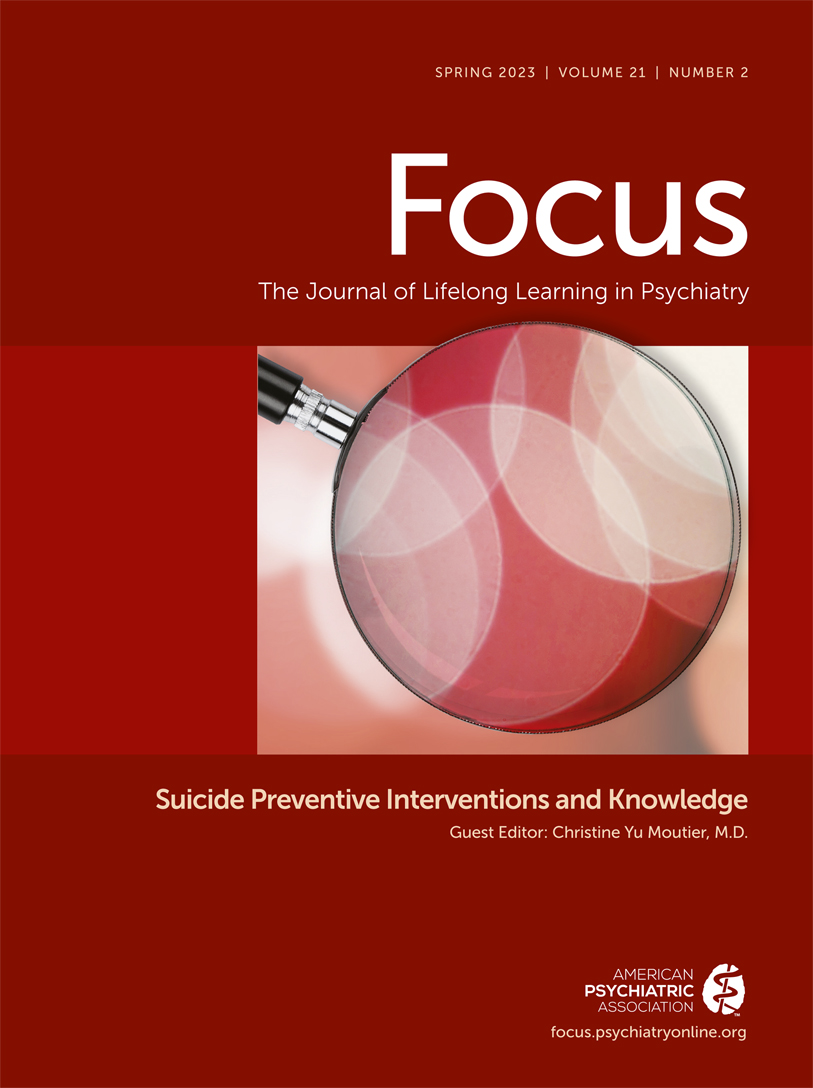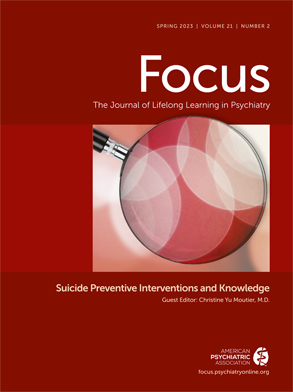Can you share clinical advice about a culturally informed approach to supporting minoritized patients who may be suicidal?
This question is timely in light of the increasing recognition that the prevalence and characteristics of suicide and suicidal behaviors differ among racial, ethnic, and sexual minoritized groups. These distinctions are often missed when looking only at suicide prevalence rates for the whole population. Researchers and clinicians have a critical role in understanding these trends in suicide and suicidal behaviors for minoritized populations in the United States to bolster our effectiveness in suicide prevention.
Recently, the Centers for Disease Control and Prevention (CDC) reported a 5% decline in rates of suicide for the U.S. population between 2018 and 2020 after a 36% increase during the 2000–2018 period. Significant demographic variations exist by age and minority status (
1). Trends identified when examining suicide rates by age, gender, and race have helped identify groups who are at higher risk. Suicide efforts have increasingly been focused on young people, as suicide remains the second leading cause of death for people 10–24 years old (
2), according to CDC data collected through 2019. In that same year, 1,646 deaths by suicide and more than 11,000 cases of intentional self-injurious behavior were observed among people 5–17 years old (
3).
Despite our efforts, suicidal ideation and attempts have continued to increase over the past 19 years (
3) among racial, ethnic, and sexual minoritized populations, reflecting disparities in care and treatment. Moreover, the racial-ethnic groups with the highest suicide rates in 2020 were non-Hispanic American Indian and Alaska Natives (23.9/100,000), and although we have seen some decline in rates for this population, they remain the group with the highest suicide rates, significantly higher than the rates for the second highest group of those who complete suicide, White men (16.9/100,000). Although suicide rates are lower among youths ages 10–24, when compared with adults, they account for the second leading cause of death for this age group and constitute 14% of all suicide deaths (
1).
Many factors are implicated in the disparities in suicide care and outcomes for minoritized groups, including racism, bias, discrimination, trauma exposure, poverty, disparities in access to care, and others. We do know, however, that access to high-quality mental health care for minoritized populations is not equitable and that this inequity is a significant contributor to rising suicide attempts and suicide rates in minoritized populations (
4–
6).
Despite these factors, we, as clinicians, have an opportunity to optimize suicide prevention for every patient, at every encounter. A comprehensive suicide risk assessment and safety planning, through cultural humility–informed practice, can provide the necessary framework for establishing the therapeutic rapport that is needed to effectively treat marginalized patients who are experiencing suicidal ideation or behaviors, have attempted suicide, or who are at risk for suicide (
7). A comprehensive suicide risk assessment that elicits the individual’s self-identity and inquires about their experiences of racism, discrimination, or bias, as well as the experience of their impacts, is essential. Establishing therapeutic communication will support effective engagement in treatment planning, effectiveness of safety planning and other interventions, and greater engagement in follow-up care. A culturally humble approach can support the clinician’s efforts to learn about the patient’s sources of support, beliefs, and communities that can foster a sense of belonging and connectedness.
SUPPORTING SUICIDAL MINORITIZED PATIENTS
Supporting suicidal minoritized patients begins with the recognition and acknowledgment that racism and discrimination are contributors to psychological distress and suicidality. This requires starting with our own beliefs, attitudes, and biases about minoritized patients. Studies of clinician bias toward racial, ethnic, and sexual minoritized patients have described differences in communication and clinical approach when providers from a majority group interact with minoritized patients. Studies of White physicians’ interactions with Black patients find less time spent with patients, shorter interactions, limited opportunities for patients to ask questions, and documentation reflecting limited engagement (
8). Other studies show missed diagnoses, incorrect diagnoses, poor-quality treatment, and failure to engage in follow-up treatment (
5,
8–
10). Recognizing our own conscious and unconscious biases, using a cultural humility–informed framework, can facilitate understanding the unique stressors, risk and protective factors, vulnerabilities, and supports that increase trust and engagement, improve mental health, and prevent suicide.
Recognizing Racial Trauma
Research attests that people of color and Indigenous individuals’ experiences with racism, discrimination, and microaggressions affect their mental and general medical health. Racism, discrimination, implicit bias, and structural inequities have severely affected health care delivery and outcomes, and historical experiences contribute to mistrust of health care providers.
Research confirms that traumatic experiences occur for minoritized individuals at significantly higher rates when compared with majority populations, and this is worsened in the context of intersectionality—individuals identifying as more than one minoritized group. Clinicians regularly assess the impacts of traumatic events but rarely inquire about racial trauma or its impacts on patients. Racial trauma is a form of race-based stress that describes the reactions of people of color and Indigenous individuals to dangerous events and real or perceived experiences of racial discrimination. These could be threats of harm and injury, humiliating and shaming events, and witnessing racial discrimination toward other people of color. It differs from other traumas in that it involves ongoing individual and collective injuries due to exposure and re-exposure to race-based stress, and it may not be recognized as a trauma by the individual experiencing it (
11). It is essential that racial trauma be integrated into our trauma-informed assessment and care of minoritized patients (
11).
Suicide Assessment Using the Cultural Humility Framework
Cultural humility is a lifelong, active approach to optimizing communication and interactions between patients and clinicians whose backgrounds, experiences, and values differ. It is a process along the cultural competence continuum, does not require expertise about groups, and is more feasible for clinicians to utilize. In this context,
culture is defined more broadly, considering race, age, ethnicity, gender identity, sexual orientation, disability, or any other identity of individual patients, including those with overlapping oppressed identities. The culturally humble clinician engages in critical self-reflection, nonjudgment, openness, and curiosity. This approach has demonstrated effectiveness in strengthening the therapeutic alliance and improving health outcomes (
7).
Ultimately, supporting the minoritized suicidal patient requires that we use the best practices that we have to date for suicide prevention for every individual patient, every time that we see them, recognizing that our risk assessment must include recognition of racism and discrimination as sources of psychological distress and trauma, as determinants of mental health generally and suicidality specifically. As caring clinicians, we are not immune to implicit and explicit biases that affect clinician-patient communication and thus result in unintended harm. A culturally humble approach can help by diminishing biases, promoting empathy, and acknowledging the patient’s experiences and individuality—inspiring hope (
12).

